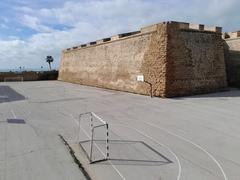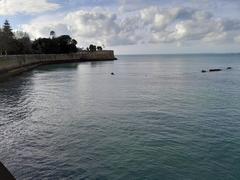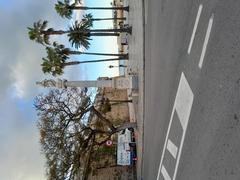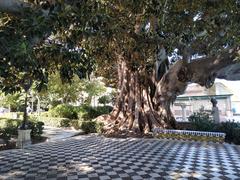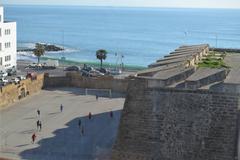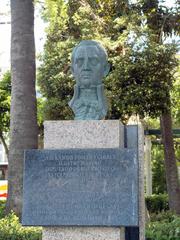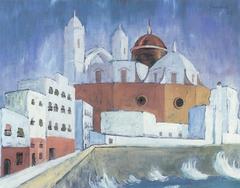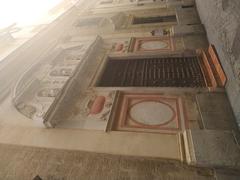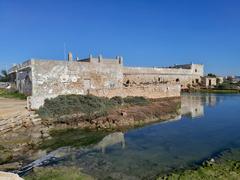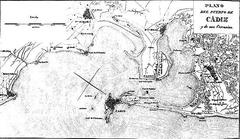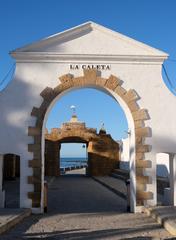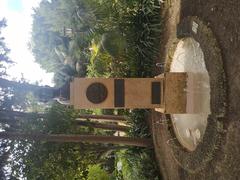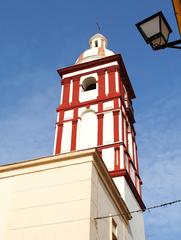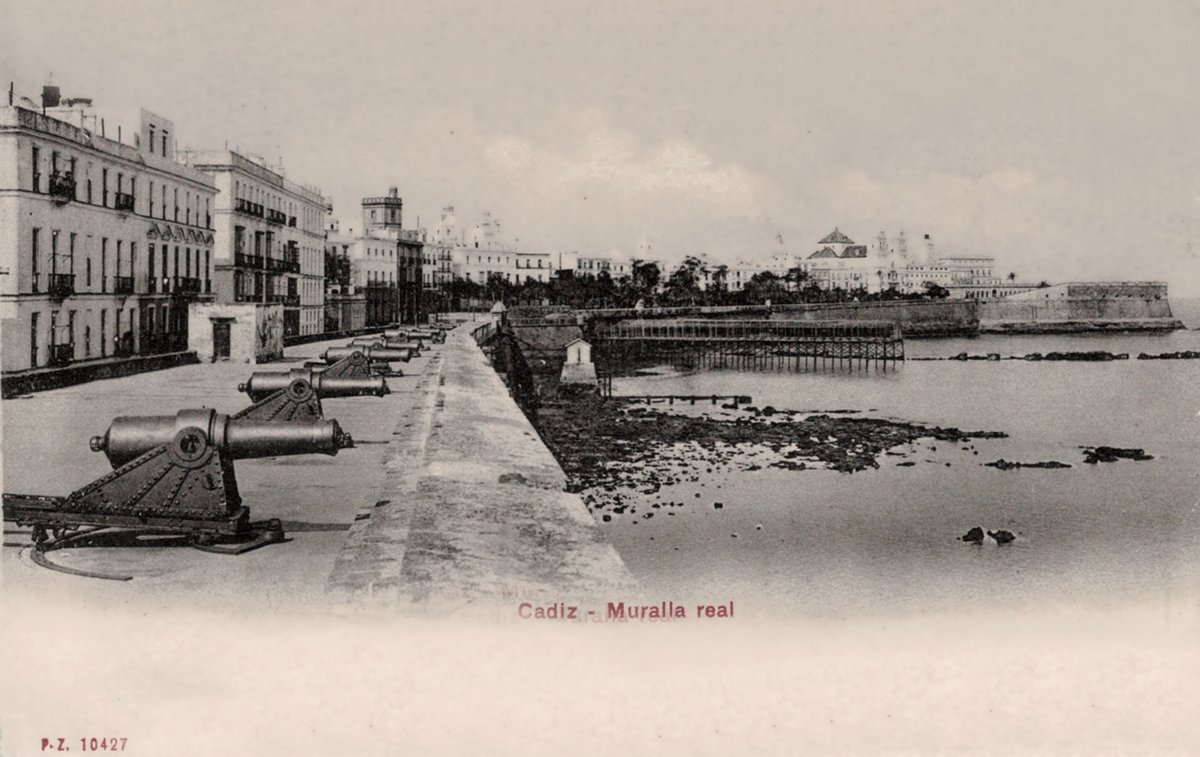
City Walls of Cádiz: Visiting Hours, Tickets, and Historical Sites Guide
Date: 14/06/2025
Introduction: The Enduring Legacy of Cádiz’s City Walls
Rising above the narrow peninsula on Spain’s Atlantic coast, the City Walls of Cádiz (“Murallas de Cádiz”) are among the country’s most significant historical fortifications. These ancient defenses encapsulate Cádiz’s remarkable journey from a Phoenician trading post established around 1100 BC to a critical stronghold in Spain’s maritime empire. The very name “Gadir”—meaning “walled stronghold”—reflects the city’s longstanding relationship with its formidable walls, which have helped it withstand centuries of sieges, invasions, and shifting empires (Visit-Andalucia; Espanaguide).
The current walls, predominantly from the 16th to 18th centuries, showcase a blend of Renaissance, Baroque, and Vauban-inspired military architecture. These defensive structures remain not only as preserved historical landmarks but also as vital public spaces, woven into Cádiz’s urban life and cultural celebrations (cadizturismo.com; VisitingCadiz.com).
This comprehensive guide provides practical information for visiting the City Walls of Cádiz, including historical insights, visiting hours, ticketing, accessibility, tour options, and nearby attractions. Whether you’re a history enthusiast or a first-time visitor, these walls offer a journey through one of Spain’s most storied cities (VisitingCadiz.com; Explored by Marta).
Historical Overview
Origins and Early Fortifications
Founded as Gadir by Phoenicians around 1100 BC, Cádiz’s natural harbor and strategic position led to early fortifications. Although the original Phoenician and Roman defenses have not survived, each successive era—Roman, Byzantine, Visigothic, Moorish, and Christian—left its mark on the city’s defensive structures (Facts.net; Wikivoyage).
Medieval and Moorish Walls
Under Moorish rule (711–1262 AD), Cádiz was fortified to defend against both Christian reconquest and sea attacks. After the Reconquista, Christian rulers rebuilt and expanded the city’s walls, enclosing the Old Town and regulating access through fortified gates (Visit-Andalucia).
The Golden Age and 18th-Century Expansion
Cádiz flourished in the 18th century, becoming Spain’s main port for American trade. This prosperity made it a target for pirates and foreign navies, prompting significant investments in its defenses. The most iconic structure from this era is the Puerta de Tierra, a monumental gateway separating the Old Town from the mainland. The city’s defensive system was reinforced with bastions, curtain walls, and offshore castles like Castillo de San Sebastián and Castillo de Santa Catalina (cadizturismo.com; Facts.net; NothingFamiliar).
Resilience in the Age of Siege
During the Peninsular War (1808–1812), Cádiz’s walls successfully resisted a prolonged Napoleonic siege, becoming a symbol of Spanish resistance and the birthplace of the 1812 liberal constitution, “La Pepa” (Espanaguide; NothingFamiliar).
Architectural Features and Key Elements
Puerta de Tierra
The Puerta de Tierra is the city’s most iconic gateway, built in the 16th century and later expanded. Flanked by imposing bastions, it features a central neoclassical arch and a 19th-century semaphore tower for optical telegraph communications (VisitingCadiz.com; thecrazytourist.com).
Bastions and Curtain Walls
Several notable bastions punctuate the walls:
- Baluarte de Candelaria: 17th-century bastion, now a cultural venue.
- Baluarte de San Roque and Santa Elena: Flank the Puerta de Tierra, providing overlapping lines of defense.
- Campo del Sur: Hosts bastions like Los Mártires and Capuchinos, defending the city’s seaward sides (cadizturismo.com).
The connecting curtain walls are constructed from local sandstone, giving them a golden hue and originally surrounded by moats (thecrazytourist.com).
Castles and Outworks
- Castillo de San Sebastián: Guards the bay’s entrance from a small island.
- Castillo de Santa Catalina: Star-shaped fortress protecting La Caleta (cadizturismo.com).
Architectural Styles
These fortifications blend Renaissance, Baroque, and Vauban military engineering influences, designed to withstand advances in gunpowder weaponry (cadizturismo.com; thecrazytourist.com).
Cultural Significance
The City Walls of Cádiz are emblems of resilience and identity, having sheltered the city through invasions and revolutions. Today, they form scenic promenades and host art exhibitions, concerts, and festivals like the renowned Carnaval de Cádiz (cadizturismo.com; visitingcadiz.com). The walls’ dramatic silhouettes have inspired artists and writers, while their integration into city life makes them a living monument (lovingspainlife.com).
Visitor Information
Visiting Hours
- City Walls: Outdoor promenades and most wall sections are open 24/7.
- Puerta de Tierra Museum: Tuesday–Sunday, 10:00 AM–6:00 PM; closed Mondays. Last entry at 5:30 PM. Check seasonal variations on official sites (VisitingCadiz.com).
- Castillo de Santa Catalina: Tuesday–Sunday, generally 10:00 AM–6:00 PM.
- Castillo de San Sebastián: Causeway open during daylight; fortress interior access is limited.
Tickets and Admission
- Walls: Free access.
- Puerta de Tierra Museum: €2–€6, with discounts for students, seniors, and children.
- Castillo de Santa Catalina: Usually free, but verify for special event pricing.
Accessibility
- Many sections, especially around Puerta de Tierra, are wheelchair accessible, with ramps and smooth paths.
- Some bastions and towers have stairs and uneven surfaces; plan accordingly if you have mobility concerns.
Tours and Suggested Routes
Self-Guided Walks
- Start at Plaza de San Juan de Dios.
- Pass through Arco del Pópulo into El Pópulo neighborhood.
- Continue to Cádiz Cathedral via Arco de la Rosa.
- Head towards the seafront and follow the walls to La Caleta (Explored by Marta).
Guided Tours
- Local guides offer in-depth 1–2 hour tours, often starting at Puerta de Tierra, covering the walls, gates, and military history (VisitingCadiz.com).
Highlights and Nearby Attractions
- Arco de la Rosa and Arco del Pópulo: Historic gates linking plazas and neighborhoods (Barceló Guide).
- Castillo de Santa Catalina: Ramparts, exhibitions, sea views.
- Castillo de San Sebastián: Causeway walks, sunset vistas.
- Cádiz Cathedral: Iconic landmark near the walls.
- Mercado Central: Vibrant market for local food.
Practical Tips
- Best Time to Visit: Spring (April–June) and autumn (September–November) for mild weather and fewer crowds (visitingcadiz.com).
- Footwear: Wear sturdy shoes for cobbled paths and uneven surfaces.
- Parking: Limited in Old Town; use public transit or park outside the walls (visitingcadiz.com).
- Language: Spanish is primary, but tourist offices offer multilingual support.
Events and Community Life
The walls serve as stages for major festivals, concerts, religious processions, and local traditions, especially during Carnaval de Cádiz and Holy Week. They are also home to art installations and seasonal illuminations (visitingcadiz.com).
Frequently Asked Questions (FAQ)
Q: Are the City Walls of Cádiz free to visit?
A: Yes, outdoor walls and promenades are free. Entry to museums and some fortresses may require a ticket.
Q: What are the opening hours for Puerta de Tierra?
A: Tuesday–Sunday, 10:00 AM–6:00 PM; closed Mondays.
Q: Are the walls accessible for people with disabilities?
A: Many areas are wheelchair accessible; some historic sections have steps.
Q: Are guided tours available?
A: Yes, both official and private guided tours are available in multiple languages.
Visual Resources
- High-quality images and interactive maps of the walls, bastions, and gates are available on VisitingCadiz.com.
- Alt text suggestions: “Panoramic view of Puerta de Tierra,” “Historic Arco de la Rosa city gate in Cádiz,” “Puerta de Tierra illuminated at night.”
Plan Your Visit
- Download the Audiala app for guided audio tours, offline maps, and updated info (Audiala).
- Visit the official Cádiz tourism website for maps, tickets, and events.
- For additional guides, see content on the Cádiz Cathedral, Roman Theater, and Castillo de San Sebastián.
Summary and Recommendations
The City Walls of Cádiz are architectural marvels and living witnesses to over two millennia of history. Their walkable ramparts, iconic gates, and scenic bastions offer an immersive experience of the city’s rich heritage. Whether you visit during vibrant festivals or in quieter seasons, these fortifications promise captivating views and deep historical resonance (Facts.net; Espanaguide). For the best experience, check current opening hours, consider a guided tour, and combine your visit with other nearby attractions (VisitingCadiz.com; Explored by Marta).
References
- City Walls of Cádiz: Visiting Hours, Tickets, and Historical Guide to Cádiz’s Iconic Fortifications, 2025, Visit-Andalucia (Visit-Andalucia)
- Cádiz City Walls: Visiting Hours, Tickets, History, and Cultural Significance, 2025, CádizTurismo (cadizturismo.com)
- City Walls of Cádiz: Visiting Hours, Tickets & Historical Sites Guide, 2025, Explored by Marta (Explored by Marta)
- Visiting the City Walls of Cádiz: Hours, Tickets, and Historical Sites in Cádiz, 2025, VisitingCadiz.com (VisitingCadiz.com)
- Cádiz Historical Facts, 2025, Facts.net (Facts.net)
- The Crazy Tourist: Best Things to Do in Cádiz, 2025 (thecrazytourist.com)
- Explored by Marta: Hidden Gems and Unique Spots in Cádiz, 2025 (Explored by Marta)
- Voyage Tips: Things to Do in Cádiz, 2025 (Voyage Tips)
- Andalucia Tourism Office: Cádiz Information Services, 2025 (Andalucia Tourism Office)
- Audiala App: Guided Audio Tours, 2025 (Audiala)

